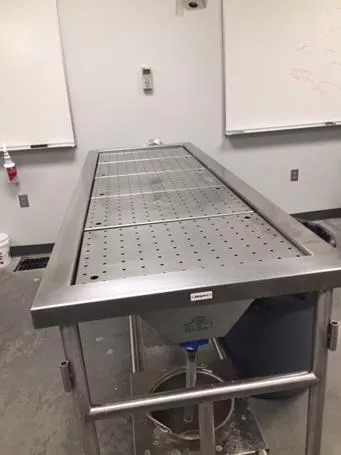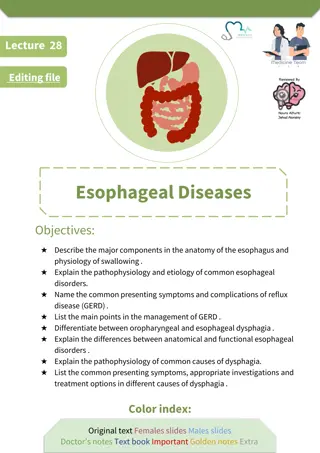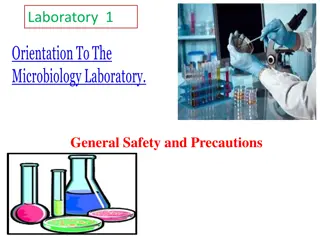Formalin Safety Guidelines in Anatomy and Physiology Laboratory
Formalin, a mixture of formaldehyde and water, is used in laboratories to preserve tissues. OSHA regulates exposure levels due to health risks. Proper ventilation and personal protective equipment are crucial to control exposure. The laboratory employs engineering controls and monitoring for safety. Health risks of formalin can be found on labels and safety data sheets. Adherence to safety protocols, including wearing protective gear and avoiding ingestion, is essential for working with formalin in the laboratory.
Download Presentation

Please find below an Image/Link to download the presentation.
The content on the website is provided AS IS for your information and personal use only. It may not be sold, licensed, or shared on other websites without obtaining consent from the author. Download presentation by click this link. If you encounter any issues during the download, it is possible that the publisher has removed the file from their server.
E N D
Presentation Transcript
Formalin Training Anatomy and Physiology Laboratory Department of Animal and Food Sciences Brigham Young University Idaho
What is formalin? Formalin is formaldehyde that has been mixed with water. Formaldehyde is an OSHA regulated chemical that is colorless, flammable, and has it s own distinct odor. OSHA sets exposure levels to formaldehyde containing solutions due to the health effects and risks that are associated with length and concentration of exposure.
How is formalin used? Formalin is used to embalm or preserve tissue or necropsy samples.
How can I control my exposure? OSHA requires that individuals are limited to specific amounts of exposure to formalin. A significant way to limit exposure is through ventilation. Our anatomy and physiology lab was designed with engineering controls and ventilation to ensure that we do not exceed these amounts. The laboratory is designed with a ventilation system to remove formalin at the necropsy table.
In order to ensure that the ventilation system at the necropsy table is working correctly a sensor has been placed on the wall by each table as shown below. The green light must be ON. If no light or a red light is on- wait for your instructors directions on how to proceed with the lab. The laboratory space is also designed to constantly bring in fresh air and remove current air. These engineering controls help to minimize exposure to any airborne formalin. These engineering controls are monitored by the University Safety Office.
Personal protective equipment protects us from the other forms of exposure such as skin contact and splashes. You will need to wear: 1. A lab coat 2. Safety Glasses or Goggles 3. Gloves 4. 5. Long pants Enclosed shoes
There should be no eating, drinking, or applying cosmetics in the laboratory to prevent unintentional ingestion.
What are the health risks of formalin? The health risks associated with formalin can be located on both the bottle label as well as the SDS (Safety Data Sheet).
Most exposures to formalin are respiratory. If you are bothered get some fresh air.
If you splash formalin in your eye go to the eyewash station and wash your eye for 15 minutes. Report this to your instructor or TA.
If you splash formalin on your skin- wash it off with soap and water. If you get a large amount on your lab coat- you should wash your lab coat. If your clothing smells like formalin- it is dirty and needs to be washed!
How do I properly dispose of formalin? Formalin is considered hazardous waste. In our laboratory we have a barrel for all excess liquid formalin. Since there is not a snorkel above the barrel- please open the outside door beside the barrel to increase ventilation. To add formalin to the barrel: 1. Look to see how full the barrel is- enough room go to step 2. (not enough room see next slide) 2. Open outside door 3. Unscrew the white cap 4. Place the funnel in the hole 5. Pour the formalin from your container into the barrel. 6. Remove the funnel 7. Screw the white cap back on the barrel. 8. Close outside door tight
If the barrel is close to the fill line (marked by tape or black marker)- do not add any more to the barrel. Add your formalin to the overflow bottle under the sink and notify your TA, Instructor, or the Lab Manager that the barrel is full and needs to be replaced. The same steps apply to using the the overflow bottle as with the barrel.
What if I spill? The formalin barrel is sitting on absorbent pads and has an absorbent ring on the top of the barrel. If your spill is more than these pads can handle you can get additional pads from the shelf to absorb the spill. Contact the lab manager to take care of the contaminated absorbent pads.
If you have a large liquid spill on the concrete floor, pour some formaldehyde solidifier (see picture) on the liquid to inhibit it s volatility, cover with an absorbent pad and notify your instructor or lab manager. The lab manger or safety office will take care of the spill from there.
Who can I contact for help? If something happens and you aren t sure what to do please contact one of the following: 1. Your laboratory TA 2. Your Instructor 3. The Lab Manager : text, call, email: 801-560-7342 or juenkej@byui.edu 4. The Safety Office : 208-496-3000































